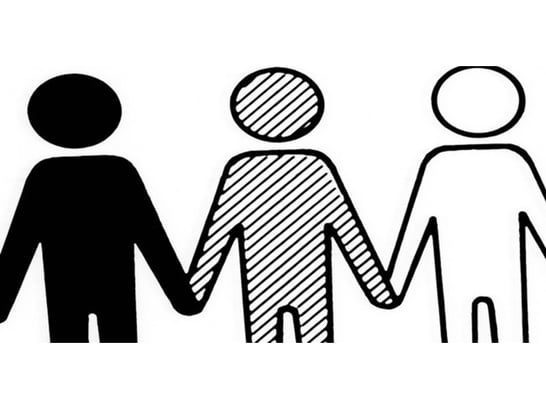As physicians, we take note of patients' demographics in part because it helps with diagnosis: Black patient with anemia? Think sickle cell. Greek patient with anemia? Think of the blood disorder thalassemia.
The Hippocratic Oath cautions us against refusing to treat patients based on these characteristics.
Doctors aren't supposed to be racist. We tend to think of ourselves not so much as people with specific identities, but more as disembodied brains and skilled hands ready to go about the work of healing.
My patient's tattoo was an unwelcome reminder that the skin I inhabit can't be checked at the hospital door.
Race is sometimes overtly discussed in health-care encounters, but usually because a patient expresses a preference for a clinician of a particular racial or ethnic background.
It is rarer for a patient to say that he or she does not want to be cared for by certain people. A few high-profile cases in the last several years involved white patients refusing care by black nurses.
While these requests are perhaps reprehensible, more controversial was the facilities' responses - in all the cases, the patients' wishes were honored. Some of the affected nurses successfully sued their employers for accommodating the racist requests, which had essentially allowed prejudice to affect their working conditions.
How should health-care providers respond to a racist, sexist, or bigoted patient? Sachin Jain is a physician of Indian descent who wrote about his experience with a patient who yelled at him to go back to India. Jain chose to yell back, a decision he later questioned.
In the New York Times' "Well" blog, Asian physician Pauline Chen revisits the Jain story and describes her own encounter with a combative swastika-decorated patient in the emergency room. She didn't wait for the patient to express his discomfort with her - she instead chose to remove herself from his presence as soon as it was clinically appropriate.
I explored the topic of racist patients in a piece for the Journal of the American Medical Association this month. I argued that I wholeheartedly reject racism and race-based prejudice, but I also recognize that patients have the right to choose their care providers and to have some control over the conditions of their care.
The therapeutic relationship between doctors and nurses and their patients is founded on mutual trust and respect; when these are missing, communication suffers and care plans fall apart. If I care for a patient who does not want me as a doctor, I have done that patient a disservice.
The responses I received to the JAMA piece were mixed. Many people thanked me for tackling a difficult issue for minority clinicians.
A few, though, criticized me for condoning inappropriate behavior. One person suggested that the clinical encounter could become a "teachable moment" in which I could fight prejudicial tendencies.
As much as I want to stamp out racism, I continue to believe that a one-on-one clinical encounter is the wrong venue to address this issue, for at least two reasons.
First, behavior is difficult to change. If I cannot persuade a patient to stop smoking or to eat more healthily, how will I convince them to shed long-held beliefs?
Second, asking for someone's respect when they are not inclined to give it is an exercise in futility. I learned that in high school.
I do think that there is a role for hospitals and other institutions to express that racism is not tolerated in clinical encounters. Similar to the "no smoking" signs that adorn healthcare facilities, I can imagine a "no offensive language or pre-judging" sign.
Health-care providers are under no obligation to treat patients in nonemergency situations, so perhaps instead of merely changing their clinicians, we should be referring bigoted patients to facilities willing to care for them.
That wouldn't have helped my trauma patient, though. He was at the brink of death, unable to declare his preference for care providers one way or the other.
As a result, he received superior care from people that he might have deemed inferior. Maybe the fact that we saved his life will serve as the ultimate teachable moment.
Source: Philly.com
 Ingrid Silva, a ballerina of The Dance Theatre of Harlem, is using the current closing of theaters and performance venues to expose racial bias in healthcare. In the past, Ingrid received praise and recognition for creating a line of ballet shoes in an array of skin tones for dancers of all races and cultures.
Ingrid Silva, a ballerina of The Dance Theatre of Harlem, is using the current closing of theaters and performance venues to expose racial bias in healthcare. In the past, Ingrid received praise and recognition for creating a line of ballet shoes in an array of skin tones for dancers of all races and cultures.


 The policy released by
The policy released by  Though discrimination exists in many forms, racial discrimination brings a unique set of implications that threaten the mental and physical health of patients and acts as a barrier to seeking care from medical professionals. Eliminating racism, therefore, is not just a concern for civil rights activists, but also for medical professionals.
Though discrimination exists in many forms, racial discrimination brings a unique set of implications that threaten the mental and physical health of patients and acts as a barrier to seeking care from medical professionals. Eliminating racism, therefore, is not just a concern for civil rights activists, but also for medical professionals. Discrimination in the United States has historically cut a wide swath across a
Discrimination in the United States has historically cut a wide swath across a  to see, the ink wasn't something I would normally have missed during my physical exam. In this case, though, his tattoo had been hidden by a bulky neck collar and the array of lines and tubes that come with being a comatose trauma patient.
to see, the ink wasn't something I would normally have missed during my physical exam. In this case, though, his tattoo had been hidden by a bulky neck collar and the array of lines and tubes that come with being a comatose trauma patient.
